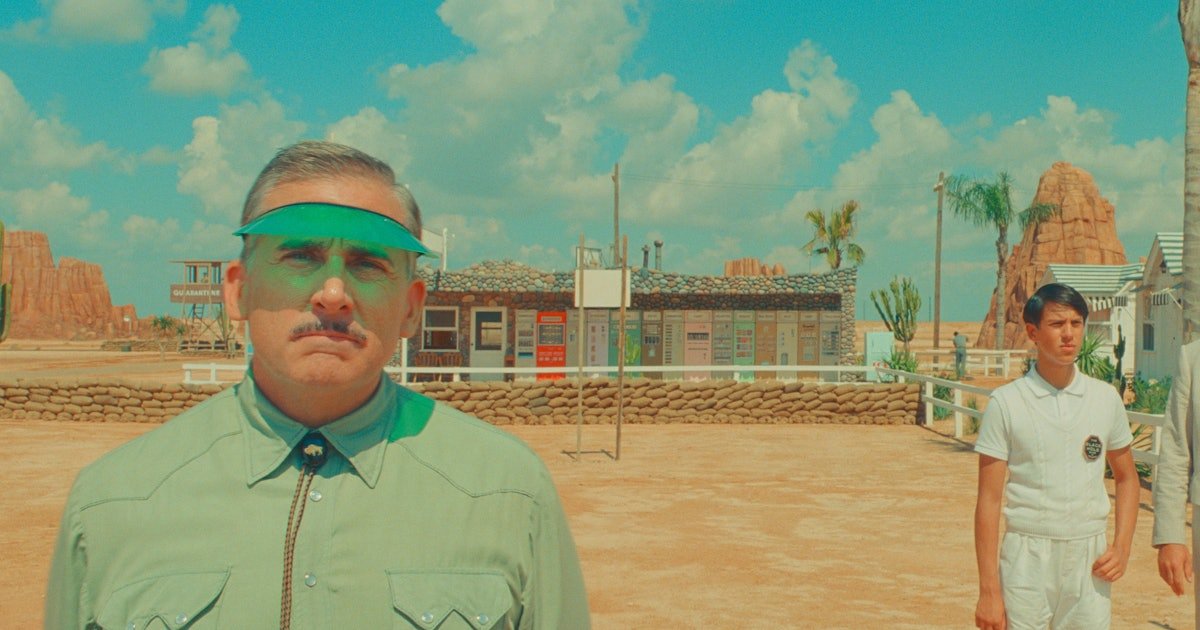Style Over Substance: The Wes Anderson Aesthetic
Junior stargazers and space cadets:
We wore pink for Barbie, and we swallowed our trepidation when we saw the run time of Oppenheimer. But there was a third movie that hit theaters this summer amidst high expectations, premiering to mixed critic reviews and ultimately grossing over $50 million at the box office. I’m referring, of course, to Wes Anderson’s Asteroid City.
I ventured to the movie theater to experience the newest addition to the famous Wes Anderson franchise—a famously visually cohesive set of films recognizable enough to inspire a recent TikTok trend. Participants frame shots of their everyday lives in the Wes Anderson style, and the result is an emulative collision of all the hallmarks that people often either love or criticize about the films.
The style is recognizable visually primarily by its unique color palette and prioritization of symmetry, as seen here. The retro costume design and notoriously thrifted props don’t hurt, either.
Image Courtesy of IMDb, Moonrise Kingdom (2012)
Transcending time periods and mediums—some of my favorite Wes Anderson films are stop-motion animation—the aesthetic is one to which many are attracted. This attraction may be explained by the balance struck within frames and the recognition of the characteristics that have become so identifiable after eleven such films. We have been, in a sense, “let in” on Wes Anderson’s sense of style over time, and have come to appreciate his approach to filmmaking as an unmistakably individual one, as unique as one’s handwriting. In watching his films, we are allowed to see his stories through his eyes, and we are never allowed to forget it.
Criticisms of Anderson’s films are often anchored on a question of style over substance. Some argue that over time, the renowned aesthetic has become a brand, and the corresponding shallowness has overtaken what were once three dimensional stories. I think, however, that the answer to whether substance has fallen by the wayside in the Wes Anderson world is found in the details of the style itself. Anderson often adheres to his own brand of formalism—an approach to filmmaking in which the techniques (lighting, framing, editing, etc.) are used to create meaning in the film—rather than the more commonplace approach of realism, where the camera records exactly as the eye would naturally see, and meaning is derived from what occurs. This differentiation accounts for what many of Anderson’s critics deride as style over substance. It is, essentially, a matter of taste in storytelling.
When we watch these films with an understanding of Anderson’s preference for formalism, we can catch a story, or several, as they unfold before us.
Wes Anderson scripts are known for their focus on often very eccentric characters partaking in a search for meaning while often maintaining flat affects. Recurring themes of navigating childhood, flawed families, and newfound relationships mark his films, regardless of their genres. Meaning seems to shift and redirect itself. Events occur out of left field, unexpected and unrealistic.
Take my most recent watch, Asteroid City, for example: Augie Steenbeck—played by a familiar face in the Wes Anderson world, Jason Schwartzman— is on his way to a Junior Stargazers and Space Cadets conference for his teenaged son, Woodrow (Jake Ryan), with his three young daughters in tow. In one fell swoop, their car breaks down in the desert and Augie breaks the news that the children’s mother died three weeks ago. This is the first they’ve heard of it.
Image Courtesy of IMDb, Asteroid City (2023)
The family makes it to Asteroid City, the site of a famous meteor where the conference is being held, and interacts with the rest of the star-studded ensemble. An alien descends (twice!), stealing and then replacing the venerated meteor. Conference goers are placed in quarantine and eventually overthrow the military members stationed in the town. Unrealistic and downright odd, you say? Well, the events in Asteroid City are actually a vibrantly colored play, a narrative embedded in a black and white story in which Augie is actually Jones, an actor merely attempting to decipher an unrealistic and odd script, just like us. Perhaps I forgot to mention that at the beginning of the film, Bryan Cranston greets us from a third layer, introducing the dramatized, made-for-television version of the making of Asteroid City the play. Much to unpack here, but it boils down to this: we are watching actors playing actors playing actors who are acting out the events above. Jason Schwartzman is playing the unnamed TV actor playing Jones, who is in turn playing Augie.
So what is Asteroid City (the movie) even about? To some it was about the art. It was about that trademark Wes Anderson style, perhaps, according to critics, to the detriment of true substance. For others, it was purely philosophical. For many, it boiled down to the slight headache they had as they left the theater.
It was about the world tilting off its axis. It was about grief.
At the climax of the play, when the alien has just made another surprise appearance to return the meteor to earth and chaos has broken out, Augie (Jones) exits the scene and seeks out the play’s director. Jones still doesn’t understand the play, and he asks Conrad Earp (Ed Norton) if he’s playing Augie correctly.
“I feel lost,” he declares, “He’s such a wounded guy. I feel like my heart is getting broken, my own personal heart, every night.”
“Good,” the director replies calmly.
“Do I just keep doing it?” Jones asks.
“Yes.”
“Without knowing anything?”
“Yes.”
Wes Anderson’s films are not examples of style at the expense of substance, but rather substance within style, and vice versa. The layering of substance combined with the sophistication of style will give Wes Anderson a third crucial element in the film industry: staying power.
Strike Out,
Writer: Sarah Singleton
Editors: Sarah Singleton and Jane Dodge
Chattanooga
Further Reading:
https://www.jukolart.us/film-technology/formalism-and-realism.html
https://www.curzon.com/journal/unpacking-wes-anderson-s-cinematic-style/
https://www.studiobinder.com/blog/wes-anderson-symmetry/


